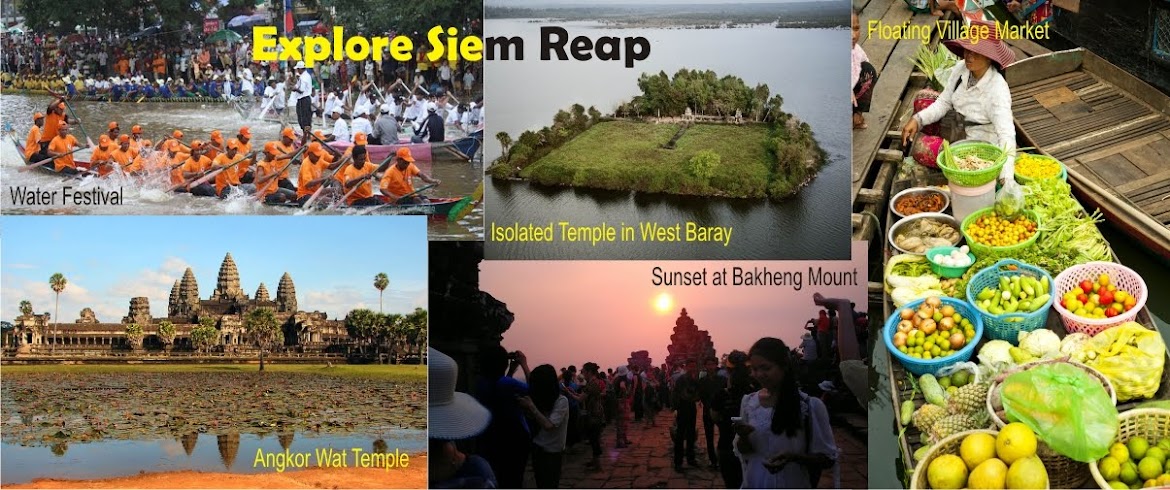This is one of the most complete and well preserved of the Angkorean monuments, with decoration of exceptional quality. It was built in the mid-12th century, a little after Angkor Wat.
The temple consists of a central sanctuary connected to a long hall opening to the east, surrounded by a first enclosure gallery with four gopuras, standing in a courtyard, surrounded by the second enclosure also with four gopuras, the Eastern one remaining unfinished. On the eastern side of the courtyard there are two elegant ‘libraries’.
The three complete gopuras have pediments with deeply carved narrative reliefs. They are larger than the ones inside the temple, of different technique and more beautifully modelled. Inside the temple, on the sarge pediments of the porches built on pillars, are reliefs inspired by the ramayana, narrating episodes of the battle of Landa, in which monkeys play a dominant role.
The pediments of the Gopuras of the second and first enclosures (indicated here as Gopuras II and I respectively) are also richly decorated, as are those of the
‘ libraries’. The absence of devatas ( apsaras) is probably due to the fact that the temple was never finished. Only a few of the pediments with narrative reliefs are described here.
1. Gopura II North, Northern face:
The best preserved of the reliefs represents the fight of Rama against Ravana on war chariots. both sculpted in higher relief to make them stand out from the background of monkeys and asuras.
Southern face: a monkey stampede on the orders of Rama mounted on Hanuman, and of Lakshmana mounted on Angada (son of Valin) (191).
2.Gopura II South, Northern face:
Monkeys building a dan with rocks to allow them to reach and conquer the island of Landa, on the half-pediment to the right. there is Vashna dilling an asura which he is holding by his hair, with rows of kinnaras(half human-half bird) and worshippers in the lower register.
Southern face: the monkey general Sushena brings Lakshmana the magic remedy to cure the terrible wounds received by Indrajit. Sushena (not Hanuman) is seen returning from the top of Mount Kailasa: on which the magical plants needed for the remedy were growing.
3. gopura II West, Western face: the battle of monkeys and rakshasas.
Eastern face: Vishnu fighting two asuras who he is clutching by the hair: on the half-pediment to the right, a procession of gods, including Vishnu on a lion. Skanda on a peacock, Yama on a buffalo.
4. Gopura II East, Eastern face: over the secondary door facing south is the fight of Krishna against the naga Kaliya, and the Churning of the Ocean of Milk (193). The latter is on two registers with the shaft of the churn passing through both; in the top register, Bramha takes over the actions of Vishnu, the devas and asuras of the lower register. at the centre of which the turtle, Kurma, is prominent.
Over the Northern entrance is a relief with the Apotheosis of Vishnu, mounted on Garuda.
Western face: facing South , a pediment showing Vishnu Trivikrama, the three steps of Vishnu. Facing North: a nicely executed Krishna lifting mount Govardana (53, page 46) and Indra’s sky attacking the rakshasas.
5. Gopura I North, South face: only the lower part of a pediment is readable. It represents two dancing apsaras with, to their left, some girls, one of whom plays the harp; on the other side three girls making the gesture of respect, their hand on their breast (198). Also depicted are Shiva and Uma on the Nandi bull (195).
6. gopura I west, eastern Face: the conjunction conjunction of the Sun and Moon, represented as two human deveneties, are each enclosed in a circle (199), surrounded by flying apsaras in the upper register of the pediment; the middle register consists of a row of kneeling ascetics, and the bottom register features a row of worshippers.
Western face: a row of gods are shown of their monts (197).
7. Central sanctuary The sanctuary tower is decorated with a series of pediments some of which show stories from the Vessantara Jataka ( glaize, 1993). the presence of Buddhist stories in a Vishnuite temple indicates the spirit of religious tolerance of the of the monuments founder. On the pediment of the long room preceding the sanctuary appears skanda on a peacock, surrounded by acolytes holding parasols; in the middle is a row of ascetics with raised arms; and below, the usual row of worshippers (196).
8. ‘Librairies’ The reliefs are not all in good condition and are of variable artistic qualtiy. One of the most striking is on the west face of the Northern ‘library’, showing the birth of Brahma (194). Vishnu reclines comfortably on a corpulent Ananta (with a head similar to that of a dragon), and from his navel a lotus stem issues vertically to end in a flower blossom on which sits brahma, surrounded by dancing apsaras.

No comments:
Post a Comment